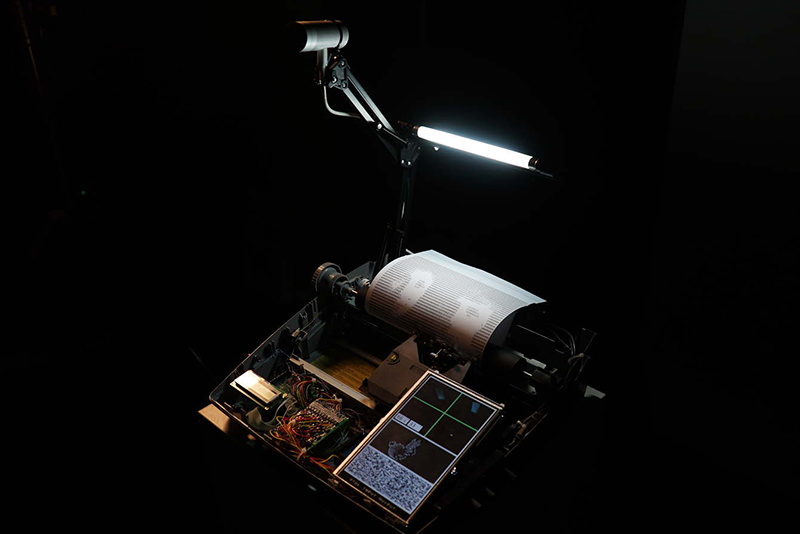[vtol] is quickly becoming our favorite technological artist. Just a few weeks ago he graced us with a Game Boy Camera gun, complete with the classic Game Boy printer. Now, he’s somehow managed to create even lower resolution images with a modified typewriter that produces ASCII art images.
As with everything dealing with typewriters, machine selection is key. [vtol] is using a Brother SX-4000 typewriter for this build, a neat little daisy wheel machine that’s somehow still being made today. The typewriter is controlled by an Arduino Mega that captures an image from a camera, converts it to ASCII art with Pure Data and MAX/MSP, then slowly (and loudly) prints it on a piece of paper one character at a time.
The ASCII art typewriter was recently shown at the 101 Festival where a number of people stood in front of a camera and slowly watched a portrait assemble itself out of individual characters. Check out the video of the exhibit below.
















Oh, it’s just a daisywheel printer… I was hoping for an actual typewriter with type bars
Are there any ascii-art libraries that would take “typewriter” style printing into account?
By which I mean the ability to carriage-return, and print over top of the current line, making much more than the basic ASCII shapes? It’d be interesting to see the level of fidelity that could be achieved.
rec.art.ascii?
rec.art.ascii is a good example.
But I question the merit of this as a hack: It works on printers of all kinds, even my 802.11-connected Brother inkjet all-in-one (which seems to understand ASCII just fine as long as there is an EOF at the end of it).
I’ve got a thermal teletype here, close to 20 years old. I found it, still powered up, after it had run out of paper about a dozen years prior.
It works great.
Should I tell the world, here on HaD about how I interfaced my modern teletype to a Linux box? Cuz, sheeeeit: Isn’t this what getty(1) is for?
There’s libcaca, although I don’t think any ASCII art lib I’ve seen supports strikeover.
Also am I only the only person in the world who hates Max MSP?
You mean like it was done back when it really was hip, over 50 years ago? http://en.wikipedia.org/wiki/ASCII_art#Line-printer_art
“[vtol] is quickly becoming our favorite technological artist.”
You mean the guy that has done all your cool cover art is in danger of being replaced????
Back in 1981, I beheld ASCII art for the first time and was pretty impressed. I didn’t know how to write code or even have a computer or a printer back then, but I did know how to load a sheet of paper into a typewriter. So yeah… I hand typed a couple of pictures. I started by lightly sketching an image, making it something like a paint-by-numbers kit, and assigning one of ten darkness gradients to each area. Then I came up with ten “characters” (which could include overstrikes) to type out those ten gradients. I loaded the sketch into the typewriter, and typed the picture. Then I erased the pencil sketch. It turned out pretty OK!
Oh. Looking at the title, I thought you meant he used the software “pure data (pd)”. But then realized it was purely data!
This seems something for people who have never been into tech at all. Oh and who have a lot of patience.
Patience! Years ago I saw a version of Star Wars in ASCII
Oh, I see it is on YouTube
VLC actually has ASCII-color as output option.
Well, back in the early days (the 60’s) we used to do this with baudot (5 bits of data) on teletype machines.. they would allow a real carriage return so that you could print many combinations of characters over top one and other to create images.. they could also be captured on paper tape and retransmitted at will.. as I recall Playboy centerfolds were a common image of the era.. :)
I remember the first digital printed “photos”. The system used an analog video camera, a monochrome frame capture card in a PC (probably an XT clone) and a dot matrix printer. I still have a big button with my face on it, printed with the system at a sales demo. Came pretty close to buying one for the T-shirt shop. https://www.flickr.com/photos/27748767@N08/17044177608/
Xantos
Sorry about above comment – anywho ! I would love an in-depth guide for the inept among the rest of you ! I’m thinking a 1960’s style president newsflash device, that would print out the news every morning !
wow amazon still sells a lot of different typewriters… I read if governments actually want to keep something secret they still use typewriters
ASCII art+cat lover=
https://user.xmission.com/~emailbox/ascii_cats.htm